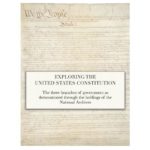Instead of placing authority in the hands of one person, like a king, or even a small group of people, the U.S. Constitution divides power. Power is first divided between the national, or federal government, and the state and local government under a system known as Federalism. At the federal level, the Constitution again divides power between the three major branches of our federal government: the legislative, the executive, and the judicial. Discover the battles of the branches in the National Constitution Center’s learning module.
Starter Kit: Federalism Podcast
A tug of war, a balancing act, two dancers dragging each other across the floor. This is the perpetual ebb and flow of power between the states and the federal government. How can things be legal in a state but illegal nationally? Are states obstinate barricades to federal legislation? Or are they laboratories of democracy?
This short episode includes a one-page Graphic Organizer for students to take notes on while listening, as well as discussion questions on the back side.
The Purposes of Government
This lesson has students learn about the purposes of government specified in the preamble of the Constitution. Students will use C-SPAN video clips to define what is meant by “establish Justice, insure domestic Tranquility, provide for the common defense, promote the general Welfare, and secure the Blessings of Liberty.” As practice, students will apply their knowledge of these purposes by viewing real-life examples of government actions and identifying the relevant purpose of government. This lesson works well in classrooms with one-to-one devices and can be adapted to flipped classrooms.
Different Government Types
This activity teaches middle and high school students about the different government systems in the world, then challenges them to create their own government.
Civics 360
Civics 360 is a comprehensive guide to middle school civics. Civics is all around us. Being informed about civics takes work. There is a lot to know about the government and how “We the People” interact with the government and each other. Use the resources in the modules to enhance your civic knowledge and skills.
Federalism
“Federalism” is the word used to describe the Constitution’s system of dividing political power between the national government and the states. What is federalism and how does it work? Why did the founders build federalism into our constitutional system and what are the modern debates over federalism today? Explore the National Constitution Center’s Federalism learning module to learn more!
Exploring the United States Constitution eBook

Each chapter connects one or more of the billions of primary source documents in the holdings of the National Archives to the principles found in the United States Constitution. These documents exemplify the workings of the three branches of the federal government as laid out in our Constitution. This eBook is available as a Multi-Touch book for iPad and Mac on iTunes, or for PC, Android devices, Mac, iPhone, iPad, or eReader with Scribd.
Government and Politics Infographics
A set of government and politics infographics that teachers can print out for their students, use for their exams, or use to create posters for their classroom.
Should the Federal Government Regulate States’ Election Procedures?
Students will be able to identify and explain aspects of the election regulation debate, including its potential impact on voter turnout, election transparency, and voting equity.
Congress and the Separation of Powers – Virtual Exhibit
Why does the U.S. Constitution separate the government into three branches? At the nation’s founding, the Constitution’s framers understood that executive, legislative, and judicial responsibilities differed, and they provided for these distinct functions. They also believed that concentrating authority in one body would result in tyranny. They therefore divided the government into legislative, executive, and judicial branches, so that no single part would become too strong, and empowered each to limit or “check” the powers of the others. This exhibit examines Congress’s unique role and the ways in which it can balance or dynamically shape and challenge the powers of two other branches.